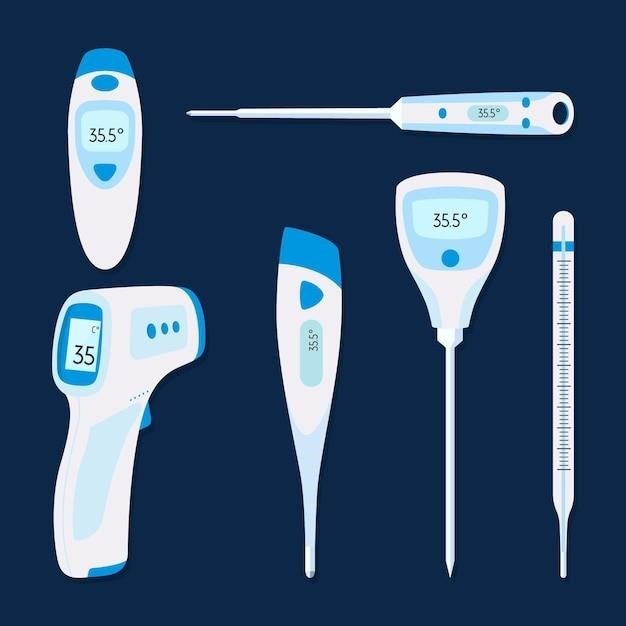Guard Thermometer Manual PDF⁚ A Comprehensive Guide
This guide provides a detailed overview of Guard thermometer manuals in PDF format. Locating your specific manual involves checking online resources, manufacturer websites, and third-party sites. Understanding specifications, calibration, troubleshooting, and safety are crucial for accurate readings and safe operation. Proper use ensures reliable temperature measurements.
Finding Your Specific Manual
The process of locating your Guard thermometer’s manual often begins with identifying the specific model number. This number, usually found on a label affixed to the thermometer itself, is crucial for pinpointing the correct manual. Once you have the model number, initiate your search online. Many manufacturers host their manuals on their websites, accessible through a search function or a dedicated support section. Look for a search bar or a downloads section, often labeled “Support,” “Downloads,” or “Manuals.” Input your model number precisely to avoid discrepancies. If the manufacturer’s website proves fruitless, explore third-party sites that specialize in accumulating and archiving product manuals. These sites frequently categorize manuals by brand and model number, making searches efficient. Remember to only download manuals from reputable sources to ensure the authenticity and accuracy of the instructions. Should all else fail, contacting the manufacturer’s customer support directly is always an option. They can usually provide a digital copy of the manual or direct you to the appropriate download link. Carefully review the manual before operating your thermometer for optimal safety and performance.
Online Resources for Manuals
The internet offers a wealth of resources for finding Guard thermometer manuals in PDF format. A simple Google search using keywords like “[Thermometer Brand] manual PDF” or “[Model Number] instructions” can yield many results. However, exercise caution when selecting a download source. Prioritize official manufacturer websites and reputable online retailers. These sources typically offer accurate and up-to-date manuals, ensuring you receive the correct instructions for your specific model. Be wary of unofficial websites or file-sharing platforms that may offer outdated, incorrect, or even malicious files. Check the website’s URL for legitimacy and look for indications of trust, such as secure connections (HTTPS) and positive user reviews. Many websites specialize in providing downloadable manuals for various products. These sites often organize manuals by brand and model number, making searching efficient. If you encounter difficulties using search engines, explore dedicated online databases that catalogue product manuals. These resources frequently maintain comprehensive archives, providing access to a wider range of manuals than a typical search engine. Always verify the source’s reliability before downloading any files to your computer.
Manufacturer Websites and Support
Manufacturer websites are the primary source for accurate and up-to-date Guard thermometer manuals. These sites usually have a dedicated “Support,” “Downloads,” or “Manuals” section where you can find PDFs for various models. Navigation is typically streamlined, allowing you to search by model number, product name, or keywords. If you’re having trouble locating your specific manual, use the manufacturer’s website search function. Many manufacturers offer multilingual support, so you can find manuals in your preferred language. Beyond manuals, manufacturer websites often provide valuable resources such as FAQs, troubleshooting guides, and video tutorials. These resources can supplement the information in the manual and assist in resolving common issues. If you can’t find your manual online, contact the manufacturer’s customer support directly. They may be able to provide you with a digital copy of the manual or guide you through alternative methods of obtaining one. Contact information, such as phone numbers, email addresses, and online forms, is usually available on the manufacturer’s website. Remember to have your thermometer’s model number readily available when contacting support for faster assistance.
Third-Party Resources for Manuals
If you’re unable to locate your Guard thermometer manual on the manufacturer’s website, several third-party resources may offer assistance. Online retailers, such as Amazon or eBay, often host product manuals as downloadable files within the product listing. Check the product description or specifications section of the relevant listing. Note that the availability of manuals on these sites can vary depending on the retailer and the specific product. Another option is to utilize general online search engines like Google, Bing, or DuckDuckGo. Search using specific keywords such as “Guard thermometer [model number] manual PDF.” Be sure to include the model number for precise results. When searching online, exercise caution and only download manuals from trustworthy sources. Avoid downloading files from unverified websites to prevent potential malware or viruses. Consider reviewing user reviews on the retailer’s site before downloading to gauge the quality and accuracy of the provided manual. If you are still unable to find your manual via the manufacturer or third-party resources, consider contacting the retailer where you purchased the thermometer. They may be able to provide support or direct you to the appropriate resources for obtaining the necessary documentation.

Understanding Thermometer Specifications
Before using your Guard thermometer, carefully review its specifications to ensure accurate and reliable readings. Key specifications to understand include the thermometer’s measurement range (minimum and maximum temperatures it can measure), accuracy (the degree of precision within which the thermometer operates; often expressed as ± a certain number of degrees), resolution (the smallest increment of temperature the thermometer can display), and response time (how quickly the thermometer registers a temperature change). Understanding the measurement units (Celsius or Fahrenheit) is also vital. The type of sensor used (e.g., infrared, thermistor) significantly impacts the thermometer’s performance and intended use. Check the manual for details on the sensor type and its limitations. The power source (batteries, AC adapter) and battery life are important for practical use. Knowing the power requirements helps in ensuring continuous operation. Some advanced thermometers may have additional features, such as data logging, memory storage, or connectivity options; Familiarize yourself with these features and their functionality. Pay close attention to any warnings or limitations stated in the specifications section of the manual. This information is critical for safe and effective use of the thermometer. Properly understanding these specifications will help you obtain accurate measurements and avoid misinterpretations.

Calibration and Maintenance Procedures
Regular calibration and maintenance are crucial for ensuring the accuracy and longevity of your Guard thermometer. The frequency of calibration depends on the thermometer’s type and intended use, but it’s generally recommended at least annually or more frequently if used extensively. Your manual will provide specific instructions for calibrating your model. This often involves comparing readings with a known accurate standard, such as a NIST-traceable thermometer. Follow the steps meticulously, noting any adjustments needed. For cleaning, use a soft, damp cloth to wipe the thermometer’s surface. Avoid harsh chemicals or abrasive cleaners that could damage the sensor or housing. If the thermometer has a probe, clean it carefully after each use, especially if used in clinical settings or with food. Proper storage is also important. Keep the thermometer in a dry, dust-free environment, away from extreme temperatures or humidity. Protect it from impacts or drops that could damage the internal components. Store the thermometer in its protective case if provided. Regular battery checks are essential for infrared thermometers. Replace batteries promptly to avoid interrupted readings. Refer to the user manual for specific maintenance instructions and troubleshooting tips. Proper calibration and maintenance will guarantee reliable and accurate temperature readings over the thermometer’s lifespan.
Troubleshooting Common Issues
Encountering problems with your Guard thermometer? Your manual provides solutions to common issues. Inaccurate readings might stem from a dead battery, improper sensor placement (for contact thermometers), or environmental factors like extreme temperatures or humidity. Always check the battery first; a low charge can cause erratic readings. Ensure the sensor is making proper contact with the object being measured. For infrared thermometers, maintain the recommended distance and angle to the target for accurate results. Erratic readings could also indicate a malfunctioning sensor. If the thermometer isn’t powering on, check the battery compartment for corrosion or damaged contacts. Clean them carefully. If the display is blank or shows strange symbols, the internal circuitry might be faulty. Refer to the manual’s troubleshooting section for specific error codes and their meanings. If the issue persists despite troubleshooting, contact customer support or the manufacturer for repair or replacement. Remember to check for any warnings or error messages displayed on the thermometer itself. These messages often provide clues to the underlying problem and potential solutions. The manual should provide a detailed list of error codes and their associated meanings. Always consult the manual’s troubleshooting section before attempting any advanced repairs or modifications yourself.
Safety Precautions and Warnings
Prioritize safety when using your Guard thermometer. Always read and understand the safety instructions in the manual before use. Never attempt to disassemble or repair the thermometer yourself; this may void the warranty and could cause injury. Keep the thermometer out of reach of children. The small parts, such as the battery and any protective caps, pose a choking hazard. Do not immerse the thermometer in water or other liquids unless explicitly stated in the manual. Avoid dropping or impacting the thermometer, as this could damage the internal components. For infrared thermometers, avoid pointing the sensor at the sun or other high-intensity light sources, which can damage the sensor. Always ensure proper ventilation around the thermometer to prevent overheating. Dispose of the thermometer properly according to local regulations. If the thermometer malfunctions or displays unexpected behavior, discontinue use immediately and contact the manufacturer or customer support. Never use the thermometer for purposes other than those specified in the manual. Pay close attention to any warning labels or symbols on the device or in the manual. These are crucial for safe and effective use. Always follow the manufacturer’s instructions for cleaning and sanitizing the thermometer. If the device involves batteries, replace them according to the instructions to avoid potential leakage and damage. Be mindful of the specific environmental conditions under which your model is designed to function, and avoid using it outside these parameters.
Interpreting Thermometer Readings
Accurately interpreting your Guard thermometer’s readings is crucial for effective use. Familiarize yourself with the thermometer’s display and understand the units of measurement (Celsius or Fahrenheit). Note that different thermometer types (oral, ear, forehead, etc.) might have slightly varied accuracy levels. The manual will specify the accuracy range for your model. Always ensure the thermometer is properly positioned and in contact with the measured surface, as incorrect placement can lead to inaccurate readings. For infrared thermometers, maintain the correct distance specified in the manual to obtain reliable results. Consider factors that could affect the reading, such as environmental temperature and the individual’s recent activity. Repeated measurements can help confirm accuracy and ensure consistency. If you notice any significant deviations from expected readings, consult your manual’s troubleshooting section or contact customer support. Understand any error codes or symbols displayed on the screen. The manual should contain a clear explanation of what these mean. Pay attention to any alerts or warnings displayed by the thermometer. These indicate potential issues with the measurement or the device itself. Compare your readings with other reliable sources if necessary. This might involve comparing readings from multiple devices or using a second thermometer for cross-referencing. Always record your readings accurately for future reference and medical record keeping.
Using the Thermometer Effectively
Effective use of your Guard thermometer hinges on understanding its specific features and following the instructions in your manual. Before each use, inspect the thermometer for any damage or debris. Ensure the battery is adequately charged or replaced if necessary. For infrared thermometers, ensure the lens is clean and free from obstructions. Follow the instructions for proper placement of the thermometer against the body or object to be measured. Maintain the correct distance for infrared models. For oral thermometers, ensure the tip is properly cleaned and disinfected before and after each use. Understand the power-on and power-off procedures. The manual should outline the steps involved. Familiarize yourself with any special features, such as memory functions, fever alarms, or backlight settings. These can greatly enhance usability. Be aware of the thermometer’s operational temperature range. Using it outside this range could compromise accuracy or damage the device. After each use, carefully clean and store the thermometer as directed in the manual. Proper cleaning and storage are crucial for prolonging the lifespan and maintaining the accuracy of your thermometer. Refer to your manual regularly to refresh your knowledge and to address any questions or concerns. Consistent, proper use is critical for obtaining reliable and accurate temperature readings.
Advanced Features and Functions
Many Guard thermometers offer advanced features beyond basic temperature measurement. These might include data logging capabilities, allowing you to record and store multiple readings over time. Some models feature connectivity to smartphones or computers, enabling easy data transfer and analysis. This is particularly useful for tracking temperature trends over extended periods. Look for features like memory recall, which allows quick access to previous readings. This can be beneficial when monitoring the temperature of an individual over time. Some thermometers offer multiple measurement modes, such as oral, rectal, or axillary for body temperature, along with surface temperature readings for objects. This versatility is useful in various applications. Advanced models may include self-diagnostic features, alerting you to potential problems such as low battery or sensor errors. This helps maintain accuracy and reliability. Some thermometers might provide fever alarms, signaling when a measured temperature exceeds a pre-set threshold. This early warning feature enhances safety, especially when monitoring infants or young children. The manual for your specific model will detail the advanced features available, along with the procedures for accessing and utilizing them effectively. Understanding these functions is key to maximizing the functionality and usefulness of your thermometer.





